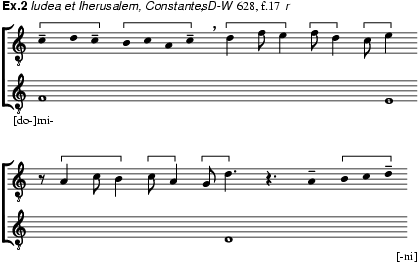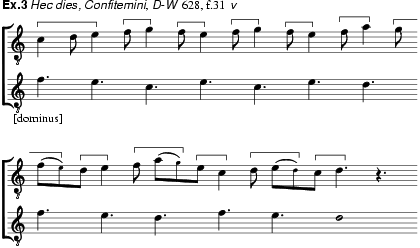
(fl Paris, 1150s–c1201). Composer of polyphony, including organum and, probably, conductus. He is credited by the theorist Anonymus 4 with perhaps the single greatest achievement in the development of early polyphony, the creation of the so-called Magnus liber. This collection is believed to constitute the matrix in which polyphony was transformed from performance practice into ‘composition’ in the modern sense of the word. In its repertory appeared a system of consonance and dissonance that would dominate polyphonic composition for the next three centuries, and also a coherent rhythmic language that, for the first time in Western music, expressed itself in its notation. No works are ascribed to Leoninus in musical sources or by contemporaneous theorists.
The identity of Leoninus has been the subject of much conjecture. Wright (1986), however, has convincingly identified him with a Magister Leonius affiliated with the cathedral of Notre Dame, Paris, during the second half of the 12th century. From the 1150s until the end of the century, Leonius acted for the cathedral as administrator of the collegiate church of St Benoît, on the Left Bank of the Seine. He must have enjoyed some standing at the cathedral for more than a decade before the construction of Notre Dame got underway, in about 1163. By 1192, he was referred to in cathedral documents as ‘magister Leonius presbyter’, indicating that he had been ordained as a priest. He had also become a canon of Notre Dame and an affiliate of the Augustinian monastery of St Victor; the position he held in the cathedral hierarchy was just below that of the eight dignitaries, next in importance after the chancellor. Leonius last appeared in a document dated 1201 and he probably died in that year or shortly thereafter. The obituaries of Notre Dame and St Victor give conflicting death dates, 24 March and 26 December, respectively. The title ‘magister’, used in documents from Notre Dame and by Anonymus 4, indicates that Leoninus had achieved the rank of magister artium, undoubtedly in Paris, and that he was licensed to teach. In addition to his musical activity, he was the author of several poetic works, including a long Hystoria sacre gestis ab origine mundi (a verse paraphrase of the first eight books of the Old Testament) and four subtly crafted letters in verse to such contemporaries as Popes Adrian IV (1154–9) and Alexander III (1159–81).
The only information concerning Leoninus's musical activity is found in the treatise of the English theorist Anonymus 4, written late in the 13th century or early in the 14th. In a parenthetical aside within his discussion of the rules of mensural notation, Anonymus 4 observed:
These rules are used in many books of the antiqui, and this from the time of the great Perotinus, … and likewise from the time of Leo, for his part … And note that Magister Leoninus, so it has been said, was the best worker with organum [optimus organista] who made [‘fecit’] the great book of polyphony [magnus liber organi] on the gradual and antiphonary to embellish the divine service. This was in use up to the time of the great Perotinus, who made a redaction of it [‘abbreviavit eundem’] and made many better clausulas, or puncta, he being the best worker with discant [‘discantor’], and better [at discant] than Leoninus was. But the same cannot be said regarding the subtlety of organum [purum], etc. (ed. Reckow, i, 46)
Several manuscripts transmit versions of the great Parisian liber organi described by Anonymus 4 (ed. Reckow, i, 46, 82; see Sources, MS, §IV, 4), but none of them can be shown to preserve Leoninus's Magnus liber in anything like the state in which he fashioned it. Consequently, there has been much speculation about what Leoninus's liber contained. It is widely accepted that it included two-voice organa for the responsorial chants of the Mass and Office – the gradual, alleluia and great responsory, and also for certain processional antiphons and the formula for the Benedicamus Domino. But Husmann's attempt (1963) to identify the organa belonging to the liber in its original state is not convincing (see Wright, 1989, chap.7). We do not know which of the surviving two-voice organa it included, or which of the extant versions (or parts of versions) of those organa are the work of Leoninus. Given the characterization ‘optimus organista’, Leoninus is often thought of in connection with organum purum, sustained-note composition, and Anonymus 4's comment implies that he was especially known for that idiom. It is for this reason that the two-voice organa in D-W 628, which make prominent use of organum purum, have been thought to preserve Leoninus's work before its recasting by Perotinus and others. But Anonymus 4 probably used the word ‘organum’ in reference to Leoninus's collection in the sense of organum generale, musica mensurabilis or polyphony in general. If so, there is nothing to suggest that Leoninus's work was limited to organum, or to music for two voices. His liber probably also included the conductus, and perhaps also organa and conductus for three voices. (Leoninus's older contemporary at Notre Dame, Albertus cantor (Albertus Parisiensis), d 1177, is the author of a conductus that survives with three voices.) It is virtually certain that Leoninus wrote not only in organum purum, but also in Discant, an idiom in which both (or all) of the voices are rhythmically active. Whatever the genres and idioms he cultivated, his music was composed for the liturgy of Notre Dame; the surviving copies of the Magnus liber conform closely to the liturgical practice of that cathedral.
Leoninus's Magnus liber undoubtedly originated in an essentially improvisatory polyphonic tradition. Exactly why, when and how that tradition was fixed in writing and then subjected to reworking remains unclear. A dynamic, rhythmically charged polyphonic line, along with a feeling for balanced phrases and for the structure of a larger span, was clearly emerging in music at this time. Leoninus's role in ‘making’ the Magnus liber may have entailed wedding the new aesthetic sensibility that arose alongside the new ‘gothic’ scholasticism and architecture with a cantorial practice that could have dated back decades, if not centuries. The style generally associated with Leoninus is one of freely flowing melismatic organum, with an extensive use of stock melodic formulas that are repeated, developed and varied in the upper voice, as in ex.1.

The impulse towards rhythmic organization that is manifest in this music was noticed by Anonymus 4, who devoted his treatise to ‘the measurement of [melodic lines] according to length and shortness, as the antiqui formulated it, and as Leo and many others thoroughly organized them according to rhythmic patterns [ordines] and melodic units [colores]’ (ed. Reckow, i, 22). The style that emerged from that impulse manifests the patterned flow of the rhythmic modes. Whether modal rhythm is present in the organum purum melismas of Leoninus's organum, however, is a matter of controversy. Waite (1954, p.8) said: ‘It was Leonin's incomparable achievement to introduce a rational system of rhythm into polyphonic music for the first time, and, equally important, to create a method of notation expressive of this rhythm’. On the other hand, Reckow (1967, ii, pp.49f) maintained that whatever the position of Anonymus 4 and other theorists may have been, and however later generations of singers may have performed this music, it is by no means the case that Leoninus conceived his organum purum in modal rhythm. But in spite of the ambiguity of passages such as ex.1, other music in the Magnus liber that is likely to be the work of Leoninus does exhibit clear modal patterning. This is true of passages of Copula (in which modal phrases occur in the upper voice over sustained tenor notes) and of many passages in discant (where the two voices move together in measured values). Most of these passages are in the first rhythmic mode (long–short–long), the intrinsically ‘trochaic’ flow of which was probably the starting-point for the development of the whole modal system. Passages in copula and discant such as those in exx.2 and 3, respectively, probably co-existed in the same piece alongside music similar to that of ex.1, the choice of idiom reflecting specifically musical constraints within the piece rather than different stages in the evolution of the Magnus liber.


Further study of the Notre Dame liturgy is needed before it will be possible to separate out Leoninus's music from that of other ‘organistae’ involved with the Magnus liber, and to assess the full scope of his achievement. In particular, scholars must identify those elements in the surviving copies of the liber that hark back to the original improvisatory practice, analyse their use in the music, and come to understand the circumstances under which this music came to be transmitted in writing.
See also Conductus, Magnus liber, Organum, Perotinus and Rhythmic modes.
MGG1 (H. Husmann)
F. Ludwig: ‘Die liturgischen Organa Leonins und Perotins’, Riemann-Festschrift (Leipzig, 1909/R), 200–13
F. Ludwig: Repertorium organorum recentioris et motetorum vetustissimi stili, i/1 (Halle, 1910/R), 15–22
J. Handschin: ‘Zur Leonin-Perotin Frage’, ZMw, xiv (1931–2), 319–32 [reply to Schmidt, below]
H. Schmidt: ‘Zur Melodiebildung Leonins und Perotins’, ZMw, xiv (1931–2), 129–34
H. Tischler: ‘New Historical Aspects of the Parisian Organa’, Speculum, xxv (1950), 21–35, esp. 31
W.G. Waite: The Rhythm of Twelfth-Century Polyphony: its Theory and Practice (New Haven, CT, 1954/R) [contains edn of Magnus liber in D-W 628]
G. Birkner: ‘Notre Dame-Cantoren und -Succentoren vom Ende des 10. bis zum Beginn des 14. Jahrhunderts’, In memoriam Jacques Handschin, ed. H. Anglès and others (Strasbourg, 1962), 107–26
H. Husmann: ‘The Origin and Destination of the Magnus liber organi’, MQ, xlix (1963), 311–30
F. Reckow, ed.: Der Musiktraktat des Anonymus 4 (Wiesbaden, 1967), i, 46, 98; ii, chap.2
F. Reckow: ‘Das Organum’, Gattungen der Musik in Einzeldarstellungen: Gedenkschrift Leo Schrade, ed. W. Arlt and others (Berne and Munich, 1973), 434–96
C. Wright: ‘Leoninus: Poet and Musician’, JAMS, xxxix (1986), 1–35
C. Wright: Music and Ceremony at Notre Dame of Paris, 500–1550 (Cambridge, 1989), 281–8
EDWARD H. ROESNER